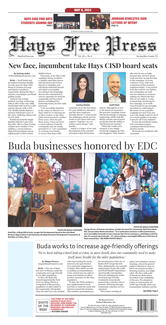This Week in Texas History
by BARTEE HAILE
On or about March 16, 1882, “Mysterious” Dave Mather posted bail, walked out of the Dallas County jail and, as was his habit, skipped town.
The future gunfighter, lawman and opportunistic outlaw was born in Connecticut the decade before the War Between the States. He was a rotten apple on a famous family tree that boasted Cotton Mather, the New England Puritan best known for his part in the Salem witch trials.
The murder of their sea captain father, stabbed to death in Shanghai by the ship’s cook, and the passing of their mother from natural causes left Dave and younger brother Sy orphans at ages 17 and 14. The teenagers went to sea but quickly learned they preferred life on dry land and jumped ship at New Orleans.
No one knows for sure where Dave Mather was or what he was doing for most of the 1870s. He may have hunted buffalo with Sy in the Texas Panhandle and rustled cattle with the Dave Rudabaugh Gang before checking out Dodge City, Kansas.
Mather’s first visit to the “Queen of the Cowtowns” was nearly his last. His stomach sliced open like a watermelon in a knife fight, he would have bled to death had it not been for the fast work of a Dr. McCarty, who stitched up the gaping wound.
The next confirmed sighting of the Connecticut Yankee was in 1878 at the Panhandle watering hole of Mobeetie. Mather and partner-in-crime Wyatt Earp tried to sell “gold” bricks to gullible frontiersmen but were run out of town before turning a profit.
By that time, Mather must have acquired a reputation as a gun-for-hire because Bat Masterson recruited him for the “Railroad War” in Kansas. With Mather, Doc Holliday, Ben Thompson, Dave Rudabaugh and other gunslingers on its payroll, the Santa Fe prevailed over the Denver and Rio Grande.
From Kansas Mather migrated to Las Vegas, New Mexico, where he hooked up again with Rudabaugh and a host of nasty characters to form the “Dodge City Gang.” This crime syndicate controlled the gambling and prostitution and also ruled the political roost.
For the first time, Mather mixed law-breaking with law enforcement. Appointed Deputy U.S. Marshal by the territorial governor, he did not let his official duties get in the way of criminal pastimes like robbing stages.
Mather recorded his initial documented kill in the Variety Hall Shootout of Jan. 22, 1880. In accordance with an ordinance forbidding firearms within the city limits, the Las Vegas town marshal tried to disarm four drunken cowboys who plugged him on the spot.
Mather, who was either in the saloon or arrived on the scene seconds later, took on the quartet by himself. When the smoke cleared, one cowboy was dead, two were wounded and the fourth was happy to be breathing and in one piece.
But all good things come to an end, even in the Old West. By March of 1880, the members of the “Dodge City Gang” realized the local tide had turned against them and one by one departed for greener pastures.
For Mather that was Dallas, where he laid low under an assumed name and romanced the black madam of the Long Branch brothel. When the lovers broke up in early 1882, Mather took her jewelry and other valuables, maybe to remember her by, but was jailed briefly on a theft charge.
By the spring of 1883, Mather was back in Dodge City and wearing a badge. Although he continued to supplement his income with the occasional armed robbery, he became a man of property with the purchase of the Opera House Saloon.
Tom Nixon owned a saloon in town too and by the summer of 1884 he also had Mather’s deputy job. Fearing his rival would strike without warning, as he was known to do, Nixon took his best shot on July 18 but inflicted only a painful powder burn.
Three days later, Mather slipped up on his attacker from behind, whispered something in his ear and shot Nixon four times before he could turn and draw. The murder was ruled a clear case of self-defense.
Mather and brother Sy, reunited once more in Dodge City, where they were playing cards with gambler Dave Jones in May 1885. A dispute escalated into gunfire, and Jones was slain by a bullet from Sy’s six-gun.
Even though the facts were on their side, the Mather boys chose not to hang around for trial. They went their separate ways, and that was the last verified sighting of “Mysterious” Dave Mather.
Sy, who lived until 1933, swore years later that he never knew what happened to his brother. One of several theories claimed Dave was spotted in a Canadian Mountie uniform as late as 1922, while another had him as a customs inspector in the state of Washington.
Then there was the report that a body found in 1886 on railroad tracks in Dallas was that of “Mysterious Dave.” However, since the positive identification was made by a bondsman anxious to get off the hook for a bail Mather had jumped, this story also must be taken with a skeptical helping of salt.
Bartee Haile welcomes your comments, questions and suggestions at haile@pdq.net or P.O. Box 152, Friendswood, TX 77549. And come on by www.twith.com for a visit!




